Page 364 of 474
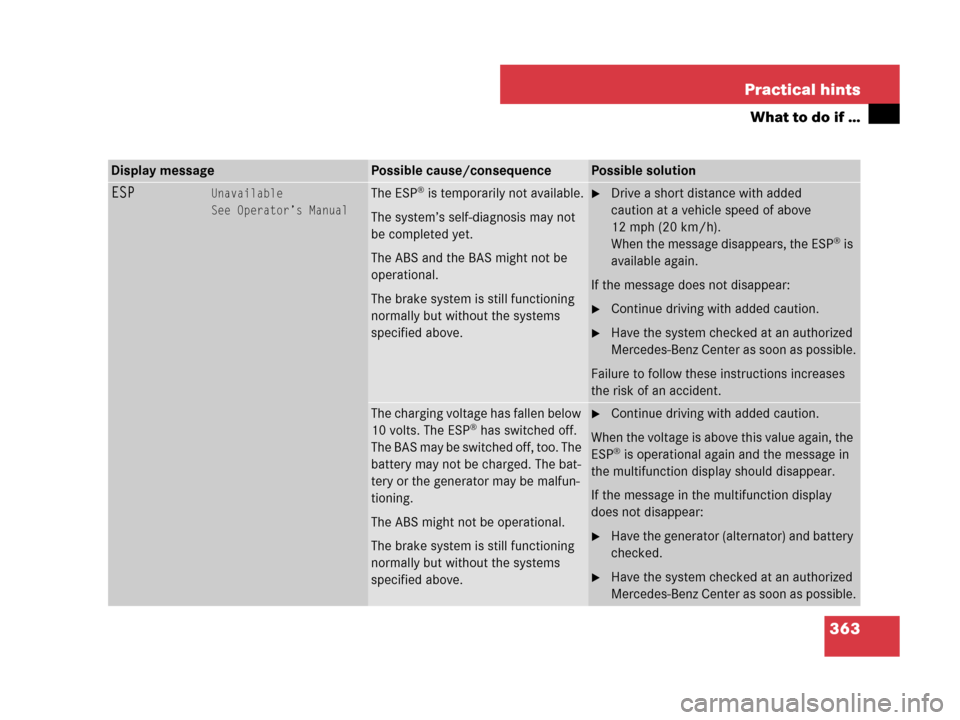
363 Practical hints
What to do if …
Display messagePossible cause/consequencePossible solution
ESPUnavailable
See Operator’s ManualThe ESP® is temporarily not available.
The system’s self-diagnosis may not
be completed yet.
The ABS and the BAS might not be
operational.
The brake system is still functioning
normally but without the systems
specified above.�Drive a short distance with added
caution at a vehicle speed of above
12 mph (20 km/h).
When the message disappears, the ESP
® is
available again.
If the message does not disappear:
�Continue driving with added caution.
�Have the system checked at an authorized
Mercedes-Benz Center as soon as possible.
Failure to follow these instructions increases
the risk of an accident.
The charging voltage has fallen below
10 volts. The ESP® has switched off.
The BAS may be switched off, too. The
battery may not be charged. The bat-
tery or the generator may be malfun-
tioning.
The ABS might not be operational.
The brake system is still functioning
normally but without the systems
specified above.
�Continue driving with added caution.
When the voltage is above this value again, the
ESP
® is operational again and the message in
the multifunction display should disappear.
If the message in the multifunction display
does not disappear:
�Have the generator (alternator) and battery
checked.
�Have the system checked at an authorized
Mercedes-Benz Center as soon as possible.
Page 373 of 474
372 Practical hints
What to do if …
Display symbolDisplay messagePossible cause/consequencePossible solution
#The battery is no longer charging.
Possible causes:
�Alternator malfunctioning
�Broken poly-V-belt
Do not forget that the brake system
requires electrical energy and may
be operating with restricted capa-
bility. Considerably greater brake
pedal force is required and the stop-
ping distance is increased.
�Stop the vehicle immediately in a safe loca-
tion and check the poly-V-belt.
If it is broken:
�Do not continue to drive.
Otherwise, the engine will overheat due
to an inoperative water pump which may
result in damage to the engine. Contact
an authorized Mercedes-Benz Center.
If it is in order:
�Contact an Mercedes-Benz Center
immediately. Adjust driving to be consis-
tent with reduced braking responsive-
ness.
USA only:
;
Canada only:
!
Release
Parking BrakeYou are driving with the parking
brake set.�Release the parking brake (�page 53).
Page 380 of 474
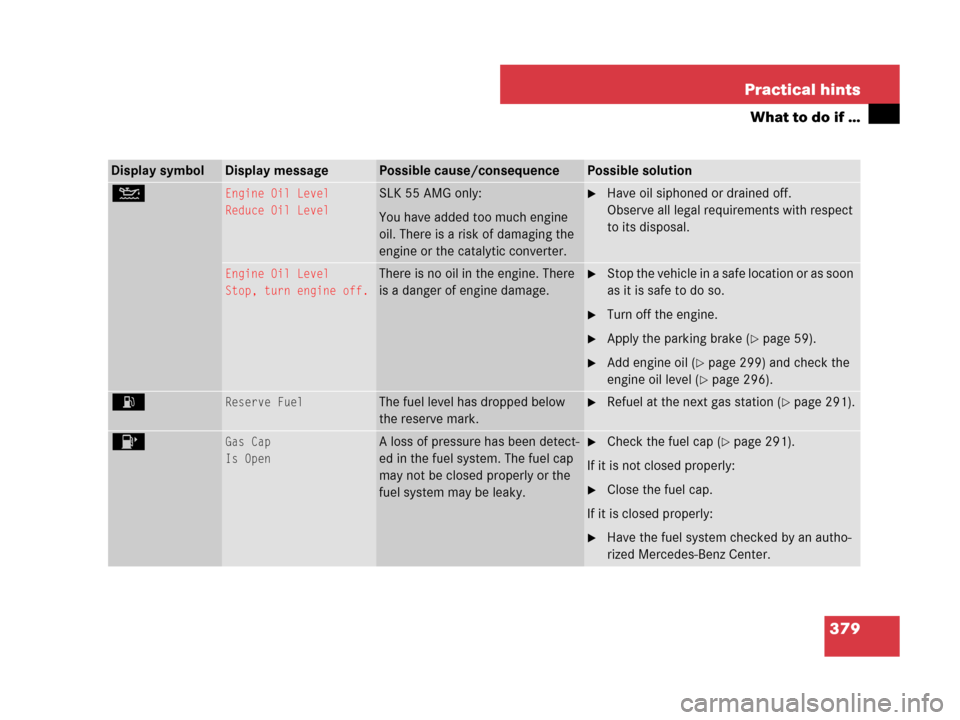
379 Practical hints
What to do if …
Display symbolDisplay messagePossible cause/consequencePossible solution
NEngine Oil Level
Reduce Oil LevelSLK 55 AMG only:
You have added too much engine
oil. There is a risk of damaging the
engine or the catalytic converter.�Have oil siphoned or drained off.
Observe all legal requirements with respect
to its disposal.
Engine Oil Level
Stop, turn engine off.There is no oil in the engine. There
is a danger of engine damage.�Stop the vehicle in a safe location or as soon
as it is safe to do so.
�Turn off the engine.
�Apply the parking brake (�page 59).
�Add engine oil (�page 299) and check the
engine oil level (
�page 296).
AReserve FuelThe fuel level has dropped below
the reserve mark.�Refuel at the next gas station (�page 291).
4Gas Cap
Is OpenA loss of pressure has been detect-
ed in the fuel system. The fuel cap
may not be closed properly or the
fuel system may be leaky.�Check the fuel cap (�page 291).
If it is not closed properly:
�Close the fuel cap.
If it is closed properly:
�Have the fuel system checked by an autho-
rized Mercedes-Benz Center.
Page 388 of 474
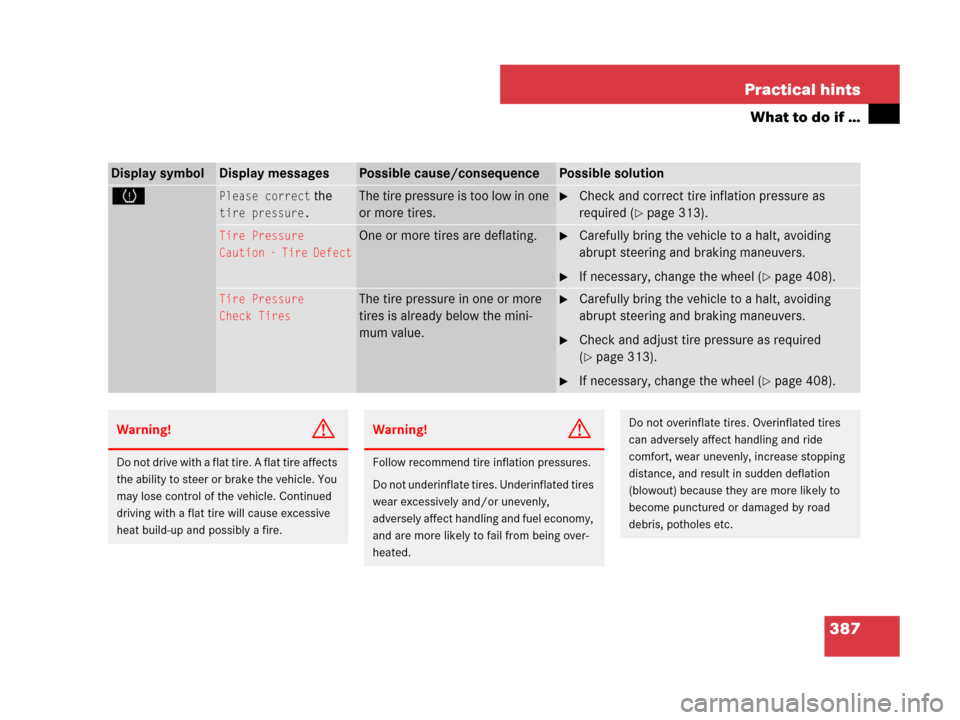
387 Practical hints
What to do if …
Display symbolDisplay messagesPossible cause/consequencePossible solution
HPlease correct the
tire pressure.
The tire pressure is too low in one
or more tires.�Check and correct tire inflation pressure as
required (
�page 313).
Tire Pressure
Caution - Tire DefectOne or more tires are deflating.�Carefully bring the vehicle to a halt, avoiding
abrupt steering and braking maneuvers.
�If necessary, change the wheel (�page 408).
Tire Pressure
Check TiresThe tire pressure in one or more
tires is already below the mini-
mum value.�Carefully bring the vehicle to a halt, avoiding
abrupt steering and braking maneuvers.
�Check and adjust tire pressure as required
(
�page 313).
�If necessary, change the wheel (�page 408).
Warning!G
Do not drive with a flat tire. A flat tire affects
the ability to steer or brake the vehicle. You
may lose control of the vehicle. Continued
driving with a flat tire will cause excessive
heat build-up and possibly a fire.
Warning!G
Follow recommend tire inflation pressures.
Do not underinflate tires. Underinflated tires
wear excessively and/or unevenly,
adversely affect handling and fuel economy,
and are more likely to fail from being over-
heated.
Do not overinflate tires. Overinflated tires
can adversely affect handling and ride
comfort, wear unevenly, increase stopping
distance, and result in sudden deflation
(blowout) because they are more likely to
become punctured or damaged by road
debris, potholes etc.
Page 391 of 474
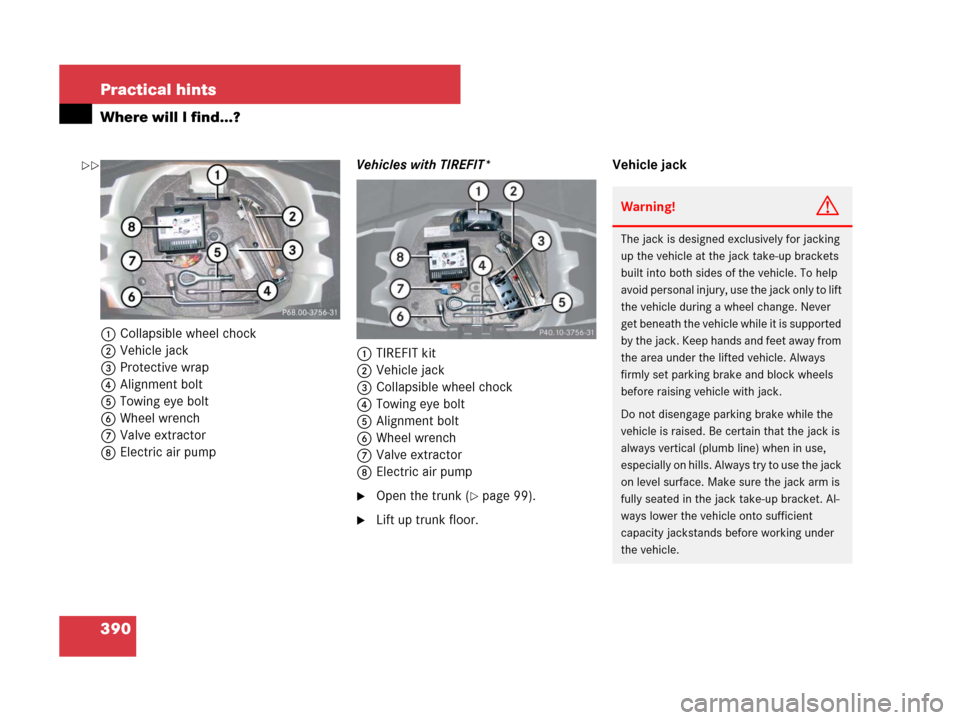
390 Practical hints
Where will I find...?
1Collapsible wheel chock
2Vehicle jack
3Protective wrap
4Alignment bolt
5Towing eye bolt
6Wheel wrench
7Valve extractor
8Electric air pumpVehicles with TIREFIT*
1TIREFIT kit
2Vehicle jack
3Collapsible wheel chock
4Towing eye bolt
5Alignment bolt
6Wheel wrench
7Valve extractor
8Electric air pump
�Open the trunk (�page 99).
�Lift up trunk floor.Vehicle jack
Warning!G
The jack is designed exclusively for jacking
up the vehicle at the jack take-up brackets
built into both sides of the vehicle. To help
avoid personal injury, use the jack only to lift
the vehicle during a wheel change. Never
get beneath the vehicle while it is supported
by the jack. Keep hands and feet away from
the area under the lifted vehicle. Always
firmly set parking brake and block wheels
before raising vehicle with jack.
Do not disengage parking brake while the
vehicle is raised. Be certain that the jack is
always vertical (plumb line) when in use,
especially on hills. Always try to use the jack
on level surface. Make sure the jack arm is
fully seated in the jack take-up bracket. Al-
ways lower the vehicle onto sufficient
capacity jackstands before working under
the vehicle.
��
Page 406 of 474
405 Practical hints
Replacing bulbs
�Fold corresponding trim to side.
�Turn the respective bulb socket coun-
terclockwise and remove.
�Press gently onto the bulb and turn
counterclockwise out of its bulb sock-
et.
�Press the new bulb gently into its bulb
socket and turn clockwise.
�Reinstall the bulb socket and turn
clockwise until it engages.
�Reinstall trim.License plate lamp
1Screws�Loosen both screws1.
�Remove the license plate lamp.
�Replace the bulb.
�Reinstall the license plate lamp.
�Retighten screws1.
Page 410 of 474
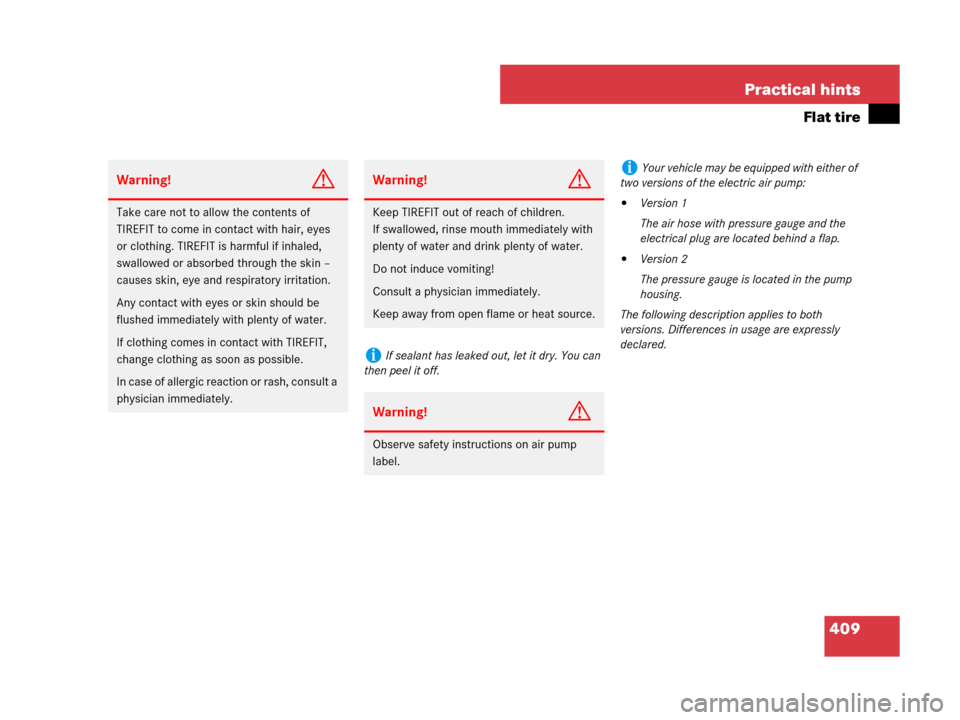
409 Practical hints
Flat tire
Warning!G
Take care not to allow the contents of
TIREFIT to come in contact with hair, eyes
or clothing. TIREFIT is harmful if inhaled,
swallowed or absorbed through the skin –
causes skin, eye and respiratory irritation.
Any contact with eyes or skin should be
flushed immediately with plenty of water.
If clothing comes in contact with TIREFIT,
change clothing as soon as possible.
In case of allergic reaction or rash, consult a
physician immediately.
Warning!G
Keep TIREFIT out of reach of children.
If swallowed, rinse mouth immediately with
plenty of water and drink plenty of water.
Do not induce vomiting!
Consult a physician immediately.
Keep away from open flame or heat source.
iIf sealant has leaked out, let it dry. You can
then peel it off.
Warning!G
Observe safety instructions on air pump
label.
iYour vehicle may be equipped with either of
two versions of the electric air pump:
�Version 1
The air hose with pressure gauge and the
electrical plug are located behind a flap.
�Version 2
The pressure gauge is located in the pump
housing.
The following description applies to both
versions. Differences in usage are expressly
declared.
Page 415 of 474
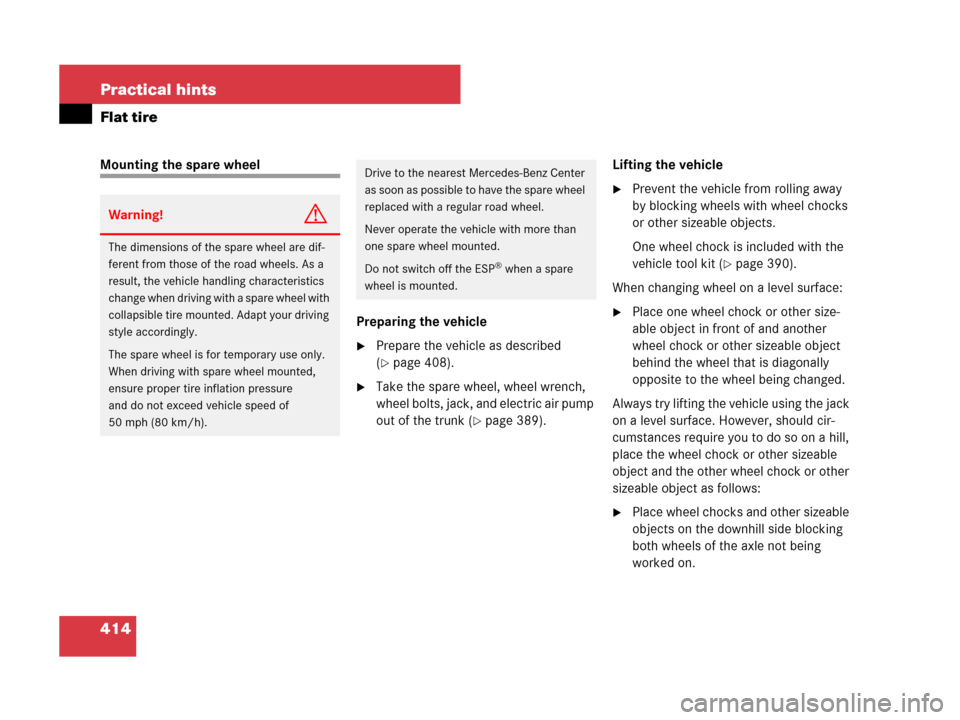
414 Practical hints
Flat tire
Mounting the spare wheel
Preparing the vehicle
�Prepare the vehicle as described
(
�page 408).
�Take the spare wheel, wheel wrench,
wheel bolts, jack, and electric air pump
out of the trunk (
�page 389).Lifting the vehicle
�Prevent the vehicle from rolling away
by blocking wheels with wheel chocks
or other sizeable objects.
One wheel chock is included with the
vehicle tool kit (
�page 390).
When changing wheel on a level surface:
�Place one wheel chock or other size-
able object in front of and another
wheel chock or other sizeable object
behind the wheel that is diagonally
opposite to the wheel being changed.
Always try lifting the vehicle using the jack
on a level surface. However, should cir-
cumstances require you to do so on a hill,
place the wheel chock or other sizeable
object and the other wheel chock or other
sizeable object as follows:
�Place wheel chocks and other sizeable
objects on the downhill side blocking
both wheels of the axle not being
worked on.
Warning!G
The dimensions of the spare wheel are dif-
ferent from those of the road wheels. As a
result, the vehicle handling characteristics
change when driving with a spare wheel with
collapsible tire mounted. Adapt your driving
style accordingly.
The spare wheel is for temporary use only.
When driving with spare wheel mounted,
ensure proper tire inflation pressure
and do not exceed vehicle speed of
50 mph (80 km/h).
Drive to the nearest Mercedes-Benz Center
as soon as possible to have the spare wheel
replaced with a regular road wheel.
Never operate the vehicle with more than
one spare wheel mounted.
Do not switch off the ESP
® when a spare
wheel is mounted.